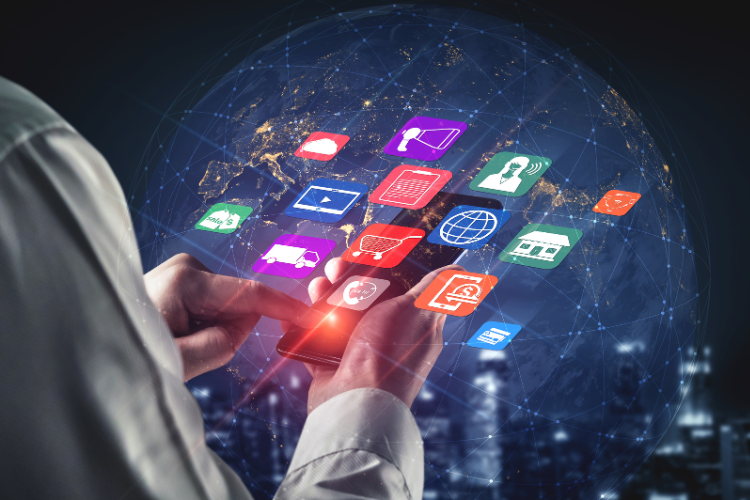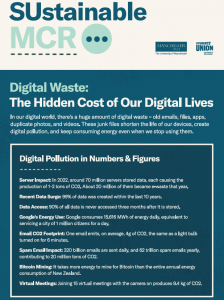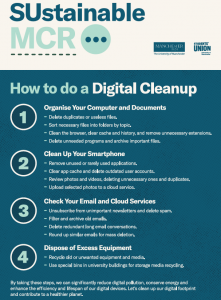
Tips for a Digital Cleanup
Blog by Giorgia Ravera (Sustainability Coordinator at University of Manchester Students’ Union) and Maggy Fostier
In 2020, the sector of information and communication technologies (ICT) was responsible for between 1.8% and 2.8% of global GHG emissions (more than aviation (1.9%)) and, if unchecked, the ICT carbon footprint could grow exponentially in coming years, along with water usage to cool the huge data servers (1).
There is no doubt that ICT, high performance computing, machine learning and AI will help us fight climate change and the biodiversity crises. For example, the capture and processing of huge data sets can help monitor and predict weather patterns and extreme weather events or improve our agriculture with targeted irrigation or the spotting of diseased crops. Bioinformatics and biomodelling avoid the need for many resource intensive lab experiments. Machine learning will become a key tool for preventative medicine and early diagnosis, saving on the huge impact generated by surgery and hospitalisations. Tele-communications, online collaboration tools and home-based/wearable e-health monitoring devices also reduce the need to travel (especially air travel).
But, like with any other tools, we must now think of ways to design and use our ICT tools more sustainably.
Manufacturers must design devices following the principles of circular economy and build them to last. For personal devices, the biggest footprint comes from the extraction of precious and finite minerals and metals and the manufacturing -also called embodied carbon (2-3). The technology has progressed dramatically to increase storage capacity, battery capacity and processing powers, so we can now envisage buying a device for the long term and repairing it when needed. This means that manufacturers must think of alternative business models that do not rely on over-consumption. This is a key challenge that business students must address urgently to help the economy transit to sustainability. In the meantime, some companies make the effort to collect our e-waste, reuse and repair what they can, and take apart the rest to select recyclable components. This is what the IT Kit amnesty was about.
Users must also learn to use ICT responsibly and reduce unnecessary compute tasks and data storage. Some of it is easier than you think and will only take a small amount of your time.
Giorgia Ravera, who has worked as Sustainability Coordinator at University of Manchester Students’ Union has created two very useful and practical posters to help us.
- The hidden cost of our digital life in data . Did you know that our digital world contains a huge amount of junk – old emails, files, apps, duplicate photos and videos? This digital waste shortens the life of our devices, creates digital pollution, and keeps consuming energy even when we stop using it. Digital waste lies in the Cloud servers’ backup and keeps using electricity to be maintained.
- Digital Clean up. How. This poster contains very simple tips to clean your device and server, and to stop the junk pollution occurring.


This work was presented during the 1st UoM Sustainability Action Month. Over a week, Giorgia’s team has engaged around 400 people and together they have deleted 3553,376 giga bites (around 1 ton of CO2e). More information is available on the Student Union website.
In our next Newsletter in October, we will present some principles of greener compute for our researchers, but if you cannot wait, check reference 4.
To find out more about Environmental Sustainability: visit the Faculty’s intranet page, website, read our ES Good Newsletter or contact srbmh@manchester.ac.uk . For more information on Environmental Sustainability at the University watch this short film or visit their website.
References:
(1) Freitag et al. 2021. The real climate and transformative impact of ICT: a critique of estimates, trends and regulations. Patterns 2, 100340.
(3) https://circularcomputing.com/news/the-world-is-running-out-of-resources-for-it/
(4) Lannelongue et al. 2023. GREENER principles for environmentally sustainable computational science. Nat Comput Sci. 3(6):514-521

0 Comments